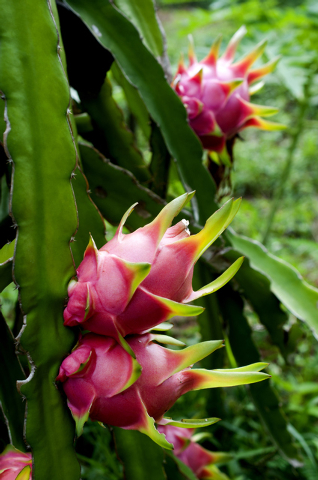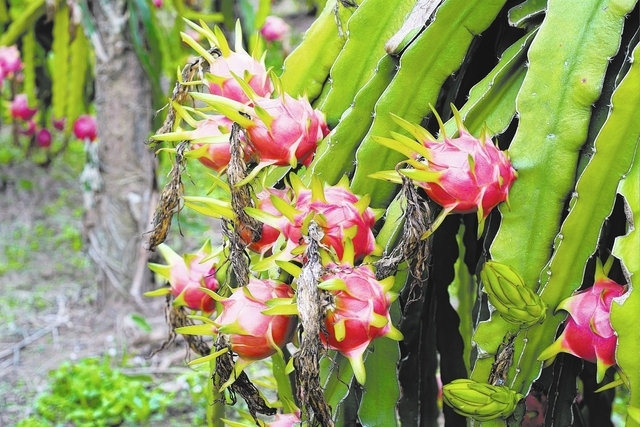Protect dragon fruit from frost, intense sunlight
Q. I am interested in raising dragon fruit. Any suggestions or comments?
A. The dragon fruit plant is a tropical climbing cactus that originated in Central and South America. The plant produces large edible fruit covered in scales. The edible fruit interior has a bland taste resembling watermelon or kiwi with slight citrus overtones.
There are several varieties with skin colors ranging from green, yellow or red. The flesh, pulp or interior of the fruit is normally white, but in some varieties it can be various shades of red.
Several other cactuses also produce similar types of large edible fruit. Collectively, these fruits are called pitaya. The cereus cactus is commonly grown in the Las Vegas area, can withstand our cold winter temperatures and may on rare occasions produce a pitaya fruit.
Many of the pitaya-producing cactuses have large white flowers that only open at night and frequently are very aromatic. Moths or bats are usually responsible for pollinating these night blooming flowers. Many pitaya require cross pollination to set fruit and so a second plant in the vicinity may be necessary.
The dragon fruit plant is sensitive to frost and harsh light intensities and must be protected from freezing weather. It also will benefit by being grown in a part of the landscape protected from late afternoon sun.
Just for fun, the plant can be started easily from seed collected from the fruit. The seed is small, so you would plant it very shallow in good planting soil. The seed should germinate in about two weeks in warm soils.
However, commercially, the plant is started from stem cuttings to maintain plants that are true to type.
Q. I grew up in a part of Texas where mesquites were bushes not trees. We have a small backyard in Las Vegas with two mesquite trees in it, one large and one slender. There is little or no green on them, just wood. There are so many woody branches I am wondering if they will ever give us shade. Would you please educate me on this?
A. The Texas mesquite or honey mesquite is a shrub that we prune into a tree form. The plant grows well here, but is usually not a preferred type of mesquite because of its long thorns. There are improved types of mesquites that are usually preferred.
With a little bit of care when they are young they can be trained into a tree form.
In our climate, many mesquites drop their leaves in winter and so are considered deciduous to semi-evergreen because of winter cold. In warmer climates they tend to stay evergreen during the winter unless there is a cold spell.
We consider our local mesquite to be a riparian species of plant. In other words, it puts on growth when water is available and slows down when water is not. When mesquite trees are watered frequently they can put on large amounts of spindly growth, perhaps 8 feet or more each year.
Mesquite are normally very deep rooted plants in the wild. Being deep-rooted gives them the capability of avoiding long periods without water. For this reason they can be drought tolerant if they have rooted deeply.
If mesquite trees are watered too often, their roots will tend to be shallow and not deep-rooted, a frequent problem in overirrigated landscapes. They also tend to put on a lot of wood because of frequent irrigations.
Mesquite trees handle pruning well and their growth is adaptable to landscape management. They do well with light fertilizer applications annually. They should be grouped with other desert plants for irrigation purposes.
After training these plants into a tree form they do not require a lot of pruning. In fact, heavy pruning just encourages a lot of new growth. I would remove lower branches just high enough to allow traffic to pass under them.
Frequent irrigations will cause these plants to be lush and provide dense shade. Watering less often will cause them to become more open and provide lighter shade. Remove branches that are crossing or growing too close together.
Limbs would be removed at their point of origin, not by hedging or simply cutting them back.
Q. My garlic planted last year has a small bulb forming at the top of a few of the plants. From what I read about this type of plant, the garlic is formed from the bulb at the top. Do they reproduce underground for future plantings?
A. We do find some garlic producing these small bulbs at the tops of the plants. They are sometimes referred to as bulblets or bulbils depending on who you talk to. These plants will also produce bulbs that can be used for planting the following year.
In the same family of vegetables there are onions that do the same thing. These are called “walking onions.” The flower at the top of the flower stalk, or scape, does not produce seed but produces miniature bulbs instead.
These bulbils are capable of reproducing the mother plant. They are called “walking onions” because the weight of the bulbils bends the scape to the ground. If the soil is wet, these bulbils grow into new plants just inches from the mother plant. This new growth gives the perception that these onions are “walking” or moving from one location to another.
These types of plants can be self-seeding by dropping the bulbils into the garden and starting new plants perpetually.
Most garlic that produces bulbils are hard-necked types of garlic or sometimes referred to as “topsetting” garlic. They are called hard-necked because the flower stalk is very rigid compared with the “softneck” varieties which can actually be braided.
So to answer your question, yes you can plant these bulbils and they will produce new plants.
It is good to remember that the size of the clove or bulbil you plant will affect the size of the bulb you produce. The larger the clove or bulbil, the larger the bulb.
Bob Morris is a horticulture expert living in Las Vegas and professor emeritus for the University of Nevada. Visit his blog at xtremehorticulture.blogspot.com.
























